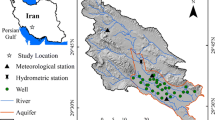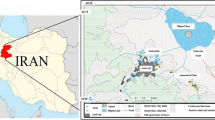Abstract
There is no doubt that groundwater is an important and vital source of water supply in arid and semi-arid areas. Therefore, prediction of groundwater level fluctuations is necessary for planning conjunctive use in these areas. This research was aimed to predict groundwater levels in the Neishaboor plain using Neural Network – AutoRegressive eXtra input (NN-ARX) and Static-NN models. The NN-ARX model determines a nonlinear ARX model of a dynamic system by training a hidden layer neural network with the Levenberg-Marquardt algorithm. In this model the current outputs depend not only on the current inputs, but also on the inputs and outputs at the pervious time periods. The available observation wells in the study area were clustered according to their fluctuation behavior using the “Ward” method, which resulted in six areal zones. Then, for each cluster, an observation well was selected as its representative, and for each zone, values of monthly precipitation, temperature and groundwater extraction were estimated. The best input of the Static-NN model was identified using combination of Gamma Test and Genetic Algorithm. Also, Gamma Test is applied to identify the length of the training dataset. The results showed that the NN-ARX model was suitable and more practical. The performance indicators (R 2 = 0.97, RMSE = 0.03 m, ME = --0.07 m and R 2 = 0.81, RMSE = 0.35 m, ME = 0.60 m, respectively for the best and worst performance of model) reveals the effectiveness of this model. Moreover, these results were compared with the results of a static-NN model using t-test, which showed the superiority of the NN-ARX over the static-NN.








Similar content being viewed by others
References
Agalbjörn S, Končar N, Jones AJ (1997) A note on the gamma test. Neural Comput Appl 5(3):131–133
Allen DM, Schuurman N, Zhang Q (2007) Using fuzzy logic for modeling aquifer architecture. J Geogr Syst 9:289–310
Allen RG, Pereira LS, Raes D, Smith M (1998) Crop evapotranspiration - Guidelines for computing crop water requirements, irrigation and drain, Paper No. 56. FAO, Rome, 300 pp
Alsaaran N A (2005) Experimental performance of spatial interpolators for groundwater salinity. Arab J Sci Eng 30(1A):3–15
ASCE Task Committee on Application of Artificial Neural Networks in Hydrology (Rao Govindaraju) (2000a) Artificial neural networks in hydrology. II: hydrologic applications. J Hydrol Eng 5(2):124–137
ASCE Task Committee on Application of Artificial Neural Networks in Hydrology (Rao Govindaraju) (2000b) Artificial neural networks in hydrology. II: preliminary concepts. J Hydrol Eng 5(2):115–123
Bierkens MFP (1998) Modeling water table fluctuations by means of a stochastic differential equation. Water Resour Res 34(10):2485–2499
Blaney HF, Criddle WD (1950) Determining water requirements in irrigated area from climatologically irrigation data. US Department of Agriculture, Soil Conservation Service, Tech. Paper No. 96
Box GEP, Jenkins GM (1976) Time series analysis, forecasting and control. Holden-Day Inc., San Francisco
Coppola JM, Szidarovszky F, Poulton M, Charles E (2003) Artificial neural network approach for predicting transient water levels in a multi layered groundwater system under variable state, pum**, and climate conditions. J Hydrol Eng 8(6):348–360
Coulibaly P, Anctil F, Aravena R, Bernard B (2001) Artificial neural network modeling of water table depth fluctuations. J Hydrol 307(4):92–111
Daliakopoulos IN, Coulibaly P, Tsanis IK (2005) Groundwater level forecasting using artificial neural networks. J Hydrol 309(4):229–240
David WS (1997) Cluster analysis: Multivariate statistics: Concepts, models, and applications. Available via DIALOG. http://www.psychstat.missouristate.edu/multibook/mlt04.htm. Cited 20 May 2010
Evans D, Jones AJ (2002) A proof of the gamma test. Proc Roy Soc Ser A 458(2027):2759–2799
Frausto HU, Pieters JG (2004) Modeling greenhouse temperature using system identification by means of neural networks. Neurocomputing 56:423–428
Gencay R, Liu T (1997) Nonlinear modelling and prediction with feedforward and recurrent networks. Phys D 108(1–2):119–134
Hargreaves GH, Samani ZA (1982) Estimating potential evapotranspiration. J Irrig Drain Div 108(3):225–230
Haugh LD, Box GEP (1977) Identification of dynamic regression (distributed lag) models connecting two time series. J Am Stat Assoc 72(397):121–130
He X, Asada H (1993) A new method for identifying orders of input-output models for nonlinear dynamic systems. Proc. of the American Control Conf., S.F., California
Hochreiter S, Schmidhuber J (1997) Long short-term memory. Neural Comput 9:1735–1780
Holland JH (1975) Adaptation in natural and artificial systems. University of Michigan Press, Ann Arbor
Hoseini A, Farajzadeh M, Velayati S (2005) The water crisis analysis in Neishaboor plain with considering environmental planning. Khorassan_Razavi Regional Water Company (in Persian)
Izady A, Davari K, Ghahraman B, Alizadeh A, Sadeghi M, Moghaddamnia A (2012) Application of “panel-data” modeling to predict groundwater levels in the Neishaboor Plain, Iran. Hydrogeol J 20(3):435–447. doi:10.1007/s10040-011-0814-2
Knotters M, Van Walsum PEV (1997) Estimating fluctuation quantities from time series of water table depths using models with a stochastic component. J Hydrol 197:25–46
Končar N (1997) Optimisation methodologies for direct inverse neurocontrol. PhD thesis. Department of Computing, Imperial College of Science, Technology and Medicine, University of London
Krishnapura VG, Jutan A (1997) ARMA neuron networks for modeling nonlinear dynamical systems. Can J Chem Eng 75(3):574–582
Lin T, Horne BG, Tino P, Giles CL (1996) Learning long-term dependencies in NARX recurrent neural networks. IEEE Trans Neural Netw 7(6):1329–1338
Ljung L (1999) System identification: Theory for the user, 2nd edn. Prentice Hall PTR, New Jersey
Ljung L (2000) System identification toolbox user’s guide. The MathWorks Inc., Natick
Maier HR, Dandy GC (1997) Determining inputs for neural network models of multivariate time series. Microcomput Civ Eng 12(5):353–368
Maier HR, Dandy GC (2000) Neural networks for the prediction and forecasting of water resources variables: a review of modeling issues and applications. Environ Model Softw 15:101–124
Masters T (1993) Practical neural network recipes in C++. Academic, San Diego
Moghaddamnia A, Remesan R, Hassanpour Kashani M, Mohammadi M, Han D, Piri J (2009) Comparison of LLR, MLP, Elman, NNARX and ANFIS Models—with a case study in solar radiation estimation. J Atmos Solar-Terr Phys 71:975–982
Morshed J, Kaluarachchi JJ (1998) Parameter estimation using artificial neural network and genetic algorithm for free-product migration and recovery. Water Resour Res 34(5):1101–1113
Nayak P, Satyaji Rao YR, Sudheer KP (2006) Groundwater level forecasting in a shallow aquifer using artificial neural network approach. Water Resour Manag 2(1):77–99
Nørgaard M, Ravn O, Poulsen NK, Hansen LK (2000) Neural networks for modeling and control of dynamic systems. Springer-Verlag London Ltd., London
Norgaard M (2000) Neural network based system identification toolbox. Ver. 2, Tech. report 00-E-891, Department of Automation, Technical University of Denmark, (http://www.iau.dtu.dk/nnbook/software.html)
Poznyak AS (1998) Learning for dynamic neural networks, in 10th Yale Workshop. Adaptive Learning Syst., pp. 38–47
Principe JC, Kuo JM, Celebi S (1994) An analysis of the gamma memory in dynamic neural networks. IEEE Trans Neural Netw 5(2):331–337
Ranjithan RS, Eheart JW, Garrett JH (1995) Application of neural network in groundwater remediation under conditions of uncertainty. In: Kundzewicz ZW (ed) New uncertainty concepts in hydrology and water resources. Cambridge Univ. Press, New York, pp 133–140
Refenes A, Burgess AN, Bents Y (1997) Neural networks in financial engineering: a study in methodology. IEEE Trans Neural Netw 8(6):1223–1267
Rizzo DM, Dougherty DE (1994) Characterization of aquifer properties using artificial neural networks: neural kriging. Water Resour Res 30(2):483–497
Sami SM, Nasr IM, Galal HG (2002) Evaluation of groundwater resources by using fuzzy Llogic in Wadi Dara Area, Gulf of Suez, Egypt. 2nd International Conference on Earth Observation and Environmental Information, Cairo, Egypt
Siegelmann HT, Horne BG, Giles CL (1997) Computational capabilities of recurrent NARX neural networks. IEEE Trans Syst Man Cybern Part B: Cybern 27(2):208–215
Stefansson A, Končar N, Jones AJ (1997) A note on the gamma test. Neural Comput Appl 5:131–133
Tabios GQ, Salas JD (1985) A comparative analysis of techniques for spatial interpolation of precipitation. J Am Water Resour Assoc 21(3):365–380
Tankersley CD, Graham WD, Hatfield K (1993) Comparison of univariate and transfer function models of groundwater fluctuations. Water Resour Res 29(10):2517–3533
Van Geer FC, Zuur AF (1997) An extension of Box-jenkins transfer/noise models for spatial interpolation of groundwater head series. J Hydrol 192:65–80
Velayati S, Tavassoli S (1991) Resources and problems of water in Khorasan province. Astan Ghods Razavi publisher, Mashhad (in Persian)
Ward J H (1963) Hierarchical grou** to optimize an objective function. J Amer Statist Assoc 58:236–244
Author information
Authors and Affiliations
Corresponding author
Rights and permissions
About this article
Cite this article
Izady, A., Davary, K., Alizadeh, A. et al. Application of NN-ARX Model to Predict Groundwater Levels in the Neishaboor Plain, Iran. Water Resour Manage 27, 4773–4794 (2013). https://doi.org/10.1007/s11269-013-0432-y
Received:
Accepted:
Published:
Issue Date:
DOI: https://doi.org/10.1007/s11269-013-0432-y




